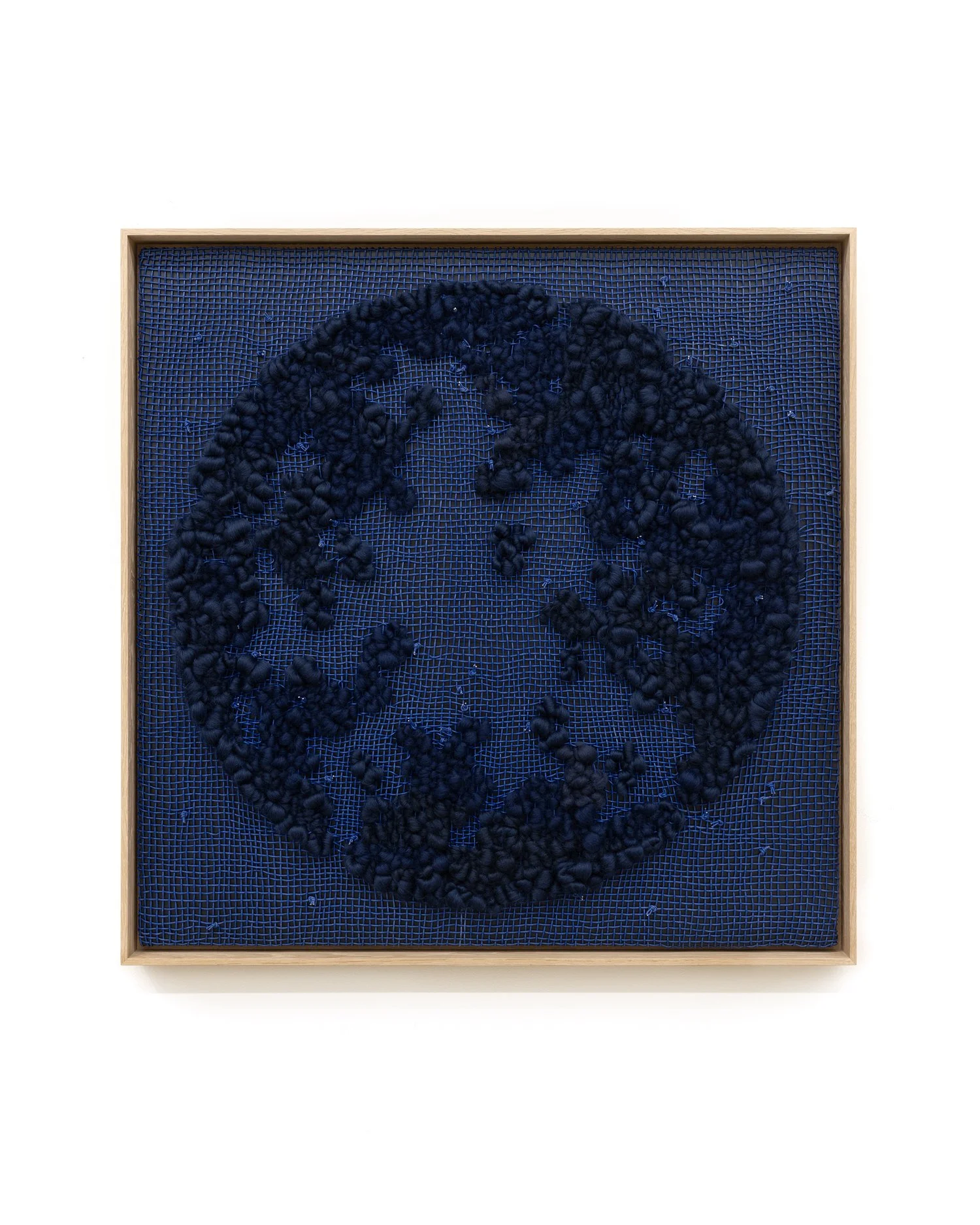Work in progress on the loom in Mimi Jung's studio.
PAREIDOLIA SERIES
Pareidolia, a type of apophenia—the broader human tendency to seek meaning in randomness—serves as the conceptual foundation of this series.
This phenomenon has its roots in Mimi Jung's early childhood experiences in Seoul, where countless hours were spent lying beneath the wooden grid of a pergola. From that vantage point, Jung took in the surrounding buildings and the drifting clouds between them, reimagining cloud shapes as familiar figures often interacting with one another—a universal pastime steeped in nostalgia.
The essence of these early experiences, the skyward perspective, is now translated onto the loom, this time without the literal depiction of 'clouds'. The grid of the pergola is faintly present in the woven warp and weft, while the recognizable shapes are depicted as puffy wool interlacing and pushing through the perpendicular painted cords.
The accidental discovery of the shapes has evolved into deliberate forms, crafted through pen sketches that precede the loom. These representations aim to capture the complexity of multifaceted personal experiences and the dynamic evolution of relationships. Only the titles allude to the emotions that steer the composition, inviting the viewer to find 'meaning'.
The Pareidolia series investigates the profound emotional responses evoked by the complexity of emotional landscapes in adulthood, depicted through familiar visual cues of childhood pastimes.
SO THEN I SAID
Painted cord, wool, painted panel and wood frame
37.5 x 37.5 x 3 in
2025
+ View more images
YES, AND
Painted cord, wool, painted panel and wood frame
37.5 x 37.5 x 3 in
2025
+ View more images
GIVE IT SOME ROOM
Painted cord, wool, silk, aluminum panel and wood frame
37.5 x 37.5 x 3 in
2025
+ View more images
SUNDAY TALES
Painted cord, wool, white oak veneer panel and wood frame
62.75 x 49.75 x 3 in
2024
+ View more images
THE ORIGIN STORY
Painted cord, wool, aluminum panel and wood frame
49.75 x 62.75 x 3 in
2024
+ View more images and video
COLD CREEK RIPPLES
Painted cord, wool, painted panel and wood frame
49.75 x 62.75 x 3 in
2024
+ View more images
THE QUIET VISIT
Painted cord, wool, painted panel and wood frame
37.75 x 37.75 x 3 in
2024
+ View more images
TWO LOOSE BRAIDS
Painted cord, wool, aluminum panel and wood frame
37.75 x 37.75 x 3 in
2024
+ View more images
OUT THERE
Painted cord, wool, painted panel and wood frame
144 x 60 x 3 in
2024
+ View more images and video
HEAR ME
Painted cord, wool, silk and painted panel
47 x 37 x 2.5 in
2021
+ View more images
ENTWINE THEMSELVES
Painted cord, wool, silk and painted panel
47 x 37 x 2.5 in
2021
+ View more images
BETWEEN US
Painted cord, wool and painted panel
47 x 37 x 2.5 in
2021
+ View more images
WE ARE CLOSED
Painted cord, wool and painted panel
52 x 28 x 2.5 in
2021
+ View more images
PERVADE THROUGHOUT
Painted cord, wool and painted panel
47 x 36 x 2.5 in
2021
+ View more images
IMBUED WITH
Painted cord, wool and painted panel
47 x 36 x 2.5 in
2021
+ View more images
PINK CLOUDS
Painted cord, wool, aluminum panel and wood frame
50.5 x 36.5 x 2.5 in
2020
+ View more images
UNSURFACED 3
Painted cord and painted panel
34 x 28.25 x 1.5 in
2021
+ View more images
UNTITLED DIPTYCH
Painted cords and painted panel
36 x 68 x 2 (36 x 30 x 2 each) in
2020
+ View more images
UNTITLED
Painted cords and painted panel
36 x 30 x 2 in
2020
+ View more images
EARLY STUDIES
UNSURFACED 2
Poly cord, paper and white oak veneer panel
28.25 x 32.25 x 1.5 in
2020
+ View more images
UNSURFACED 1
Poly cord, paper and painted panel
32.25 x 28.25 x 1.5 in
2020
+ View more images
DARK BLUE CLOUDS
Painted cord, wool, painted panel and wood frame
64 x 48 x 2.625 in
2019
+ View more images
WHITE CLOUDS
Painted cord, wool, white oak veneer panel and wood frame
40 x 60 x 3 in
2017
+ View more images
WHITE CLOUDS VERTICAL
Painted cord, wool, white oak veneer panel and wood frame
66 x 36 x 2.625 in
2019
+ View more images
YELLOW WHITE CLOUDS
Painted cord, wool, aluminum panel and wood frame
36.5 x 50.5 x 2.5 in
2020
+ View more images
WHITE CLOUDS VERTICAL 2
Painted cord, white oak veneer panel and wood frame
54 x 28 x 2.625 in
2019
+ View more images
WHITE CLOUDS 2
Painted cord, wool, white oak veneer panel and wood frame
36 x 65 x 2.5 in
2019
+ View more images










































